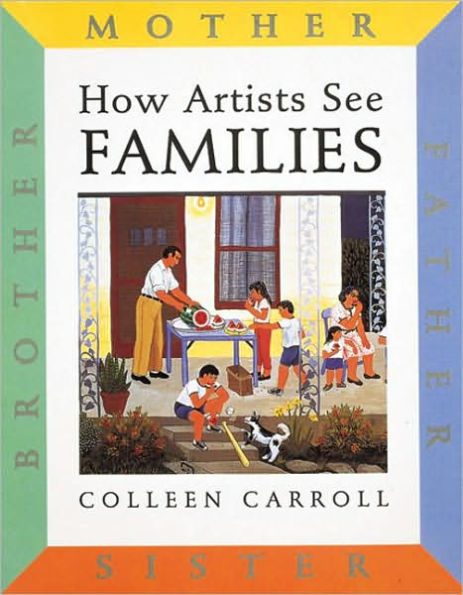

-
PICK UP IN STORECheck Availability at Nearby Stores
Available within 2 business hours
Related collections and offers
Overview
How Artists See is a breakthrough series of interactive, inquiry-based books designed to teach children about the world by looking at art and about art by looking at the world. Each volume presents sixteen diverse works of art, all devoted to a subject that every child already knows from personal experience. Author Colleen Carroll's engaging, conversational text is filled with thought-provoking questions and imaginative activities that spark children's natural curiosity both about the subject of the artwork they are looking at and about the way it was created.
This direct, interactive approach to art-and to the world-promotes self-exploration, self-discovery, and self-expression. The books introduce basic artistic concepts, styles, and techniques, and are loads of fun. For children who want to know more about the artists whose works appear in each book, biographies are provided at the end, along with suggestions for further reading and an international list of museums where each artist's works can be seen.
As children begin to understand the multitude of ways that artists see, they will deepen their appreciation of art and artists, of the world around them, and of their own unique vision.
OtherDetails: 32 full-color illustrations 48 pages 7 x 7"
"Carroll's series... eclipses the competition... How Artists See has the makings of a classic—a core experience for budding art enthusiasts to build on." —Publishers Weekly
"Wow! . . . It just doesn't get any better than this." —Children's Literature Choice list 1997
Author Biography: Colleen Carroll is an educational consultant whose clients include Nickelodeon, MTV, USA Today, and the Smithsonian Institution's National Museum of American History. She has taught sixth grade in California and now develops the art curriculum for The Edison Project. She lives in New York.

Product Details
| ISBN-13: | 9780789201881 |
|---|---|
| Publisher: | Abbeville Publishing Group |
| Publication date: | 09/28/1997 |
| Series: | How Artists See Series |
| Pages: | 48 |
| Product dimensions: | 7.08(w) x 9.26(h) x 0.34(d) |
| Age Range: | 8 Years |
About the Author
Colleen Carrollis an educational consultant whose clients include Nickelodeon, MTV, USA Today, and the Smithsonian Institutions National Museum of American History. She has taught sixth grade in California and now develops the art curriculum for The Edison Project. She lives in New York.
Read an Excerpt
NOTE TO PARENTS AND TEACHERS
As an elementary school teacher I had the opportunity to show my students many examples of great art. I was always amazed by their enthusiastic responses to the colors, shapes, subjects, and fascinating stories of the artists' lives. It wasn't uncommon for us to spend an entire class period looking at and talking about just one work of art. By asking challenging questions, I prompted the children to examine and think very carefully about the art, and then quite naturally they would begin to ask all sorts of interesting questions of their own. These experiences inspired me to write this book and the other volumes in the How Artists See series.
How Artists See is designed to teach children about the world by looking at art, and about art by looking at the world through the eyes of great artists. The books encourage children to look critically, answer—and ask—thought-provoking questions, and form an appreciation and understanding of an artist's vision. Each book is devoted to a single subject so that children can see how different artists have approached and treated the same theme and begin to understand the importance of individual style.
Because I believe that children learn most successfully in an atmosphere of exploration and discovery, I've included questions that encourage them to formulate ideas and responses for themselves. And because people's reactions to art are based on their own personal aesthetic, most of the questions are open-ended and have more than one answer. If you're reading aloud to your children or students, give them ample time to look at each work and form their own opinions; it certainly is not necessary to read thewhole book in one sitting. Like a good book or movie, art can be enjoyed over and over again, each time with the possibility of revealing something that wasn't seen before.
You may notice that dates and other historical information are not included in the main text. I purposely omitted this information in order to focus on the art and those aspects of the world it illustrates. For children who want to learn more about the artists whose works appear in the book, short biographies are provided at the end, along with suggestions for further reading and a list of museums where you can see additional works by each artist.
After reading How Artists See, children can do a wide variety of related activities to extend and reinforce all that they've learned. In addition to the simple activities I've suggested throughout the main text, they can draw or paint a family portrait, construct a family tree, or plan and cook a special family meal. Since the examples shown here are just a tiny fraction of the great works of art that feature families as their subject, children can go on a scavenger hunt through museums and the many art books in your local library to find other images of families.
I hope that you and your children or students will enjoy reading and rereading this book and, by looking at many styles of art, discover how artists share with us their unique ways of seeing and depicting our world.
Table of Contents
Note to Parents and TeachersArtists' Biographies
Suggestions for Further Reading
Where to See the Artists' Work
